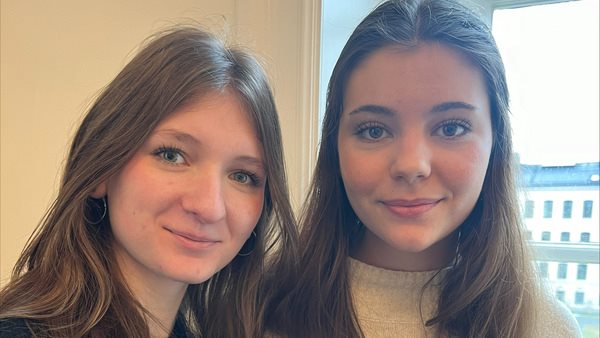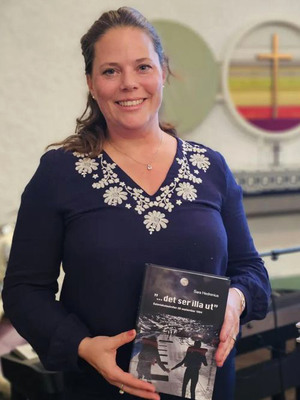Sara Hedrenius, the woman that survived Estonia disaster
In the middle of the night on the 28th of September 1994 something happened that would change Sweden forever. The large passenger ferry Estonia sank in the Baltic sea on its route between Tallinn and Stockholm. Of the 989 passengers on board, 852 would never come ashore again, and never return to their families and homes.

Ida Kiesow (vänster) och Sofia Almcrantz Correia (höger)
by Sofia Almcrantz Correia, SA24
In the middle of the night on the 28th of September 1994 something happened that would change Sweden forever. The large passenger ferry Estonia sank in the Baltic sea on its route between Tallinn and Stockholm. Of the 989 passengers on board, 852 would never come ashore again, and never return to their families and homes.
Most of the passengers on Estonia that night were from Sweden. 501 Swedes died, while only 51 survived. In this interview, we will meet one of them, Sara Hedrenius, who was only 20 years old when the Estonia disaster happened. She tells us about her experiences that night and how they affected the rest of her life.
Almcrantz: It’s been thirty years since the Estonia disaster. What are your memories before everything started to go wrong that night?
Hedrenius: I remember walking around on the boat, a strong wind was blowing and it was raining heavily. As soon as we reached the open sea the boat started rocking, so much so that the crew handed out barf bags. The rocking continued all evening and because I felt sick I tried to go to sleep. I didn’t have a cabin, so instead I laid down on a couch near a cafeteria. After a while I was awakened by a loud bang. At first I tried to find a reasonable explanation for the loud noise, thinking that the boat was just hitting a big wave, but then the next bang came. Now the boat didn’t rock all the way back and instead started to tilt, in a way that was alarming. That was when I realized that something was wrong.
Almcrantz: What did you do at that point?
Hedrenius: The first thing I did was to take my passport and wallet. After that, my only thought was to try to get out on deck. To get there, I had to go up two floors. The situation felt strange as most of the other passengers were still sitting down in their seats or in the cafeteria. There were only four or five of us trying to get out. But when the boat tilted even more, most people understood that something was wrong and afterwards many people came out on deck, some in their pajamas or just in their underwear.
Almcrantz: Even though you were only twenty years old, you got a lot of attention in the media after the accident.
Hedrenius: Yes that is true, I think it’s because I was one of the few who could tell the story. There were only 51 swedes who survived, and many of the others lost family members or friends in the accident. I was travelling alone so it wasn’t as painful to do an interview, and when I talked about how me and Kent helped each other during the catastrophe everyone went crazy!
Almcrantz: That brings me to my next question, could you tell us about your collaboration with Kent that night?
Hedrenius: When I got out on the deck, I heard someone shouting for “someone strong” who could help to bring down a life raft and I thought “at least I’m twenty years old” so I went there to help out. We eventually succeeded and all of a sudden he turned to me, shook my hand and said “Hello my name is Kent Härstedt” I thought it was a bit “too much” so I laughed and said “And my name is Sara”. Then he proceeded to ask me if we could help each other out during the night in order to survive.
Almcrantz: How did the collaboration go during the night, how exactly did you help each other?
Hedrenius: To be honest we sort of bantered a lot. We also had serious conversations, however, I think when you are in a crisis it’s completely natural to try to find something humorous about the dreadful situation just to endure. When Estonia sank, we managed to get into a life raft. It was the middle of the night at the end of September, so it was dark and very cold. Our life raft had ended up upside down and with loads of water in the middle. It was really hard to hold on, the big waves were washing over us and if you lost your grip you could be washed away. The situation was so dangerous, and you also risked freezing to death, so me and Kent also helped each other keep warm by sitting close to one another.
Almcrantz: What went through your mind when surrounded by this horrible environment?
 Sara Hedrenius with her book … Det ser illa ut
Sara Hedrenius with her book … Det ser illa ut
Hedrenius: What a great question! During the night I of course thought a lot about my mum, dad and sister. Besides that, I believe that most of my focus was just on staying in that life raft. If you got lost in your thoughts, you could easily lose focus and be pulled away by a wave. In this matter Kent and I also helped each other a lot. The situation was so tough, so it was necessary to get some rest from time to time. Sometimes Kent would slip away in his thoughts while I kept an eye on him, and I would say, “Hey Kent, wake up!” Then he checked on me.
Almcrantz: How long did it take before you were rescued?
Hedrenius: We were rescued at half past five in the morning. By that point in time we had been in the raft about five-and-a-half to six hours.
Almcrantz: What motivated you not to give up?
Hedrenius: I don’t really know… I think it helped me that I was young and that I understood that help would come, so I just had to keep on going until I was saved. In that situation I would have done absolutely everything to see my family again.
Almcrantz: How have your experiences after that night thirty years ago shaped who you are today?
Hedrenius: Right before the disaster I visited my dad who was working in Estonia and he asked me what I wanted to study, and I said “I have no idea”. But thanks to my experience aboard Estonia, I became interested in psychology, specifically related to crisis management. And now I’ve been working in crisis and catastrophe management for twenty years. Another thing is that when I almost drowned that night and I thought that I would die, I remember thinking, “I will never have the chance to have children,” a thought I never had before the disaster. Later in life when I met my husband, we had my daughter when I was 27 years old, which is quite young.
Almcrantz: The Estonia catastrophe has been a trauma for Sweden; is there anything you wish the authorities had done differently?
Hedrenius: There are many things I believe were done wrong. First of all, we survivors were not interviewed by the commission overseeing the accident, and the report that was released about Estonia was very bad. For me, the decision to leave the people who had passed away in the accident inside the boat at the bottom of the sea is very strange.
Almcrantz: Finally, what does the future hold for you?
Hedrenius: I plan to write a book for young adults about Estonia. A while ago I met a young girl who had lost her grandmother in the catastrophe. In school she had read a lot about the Titanic but never once learnt about the Estonia accident. That’s why it’s so important to have a good investigation that explains the real cause of the accident, so people can talk and remember this catastrophe and all those who did not survive it.
